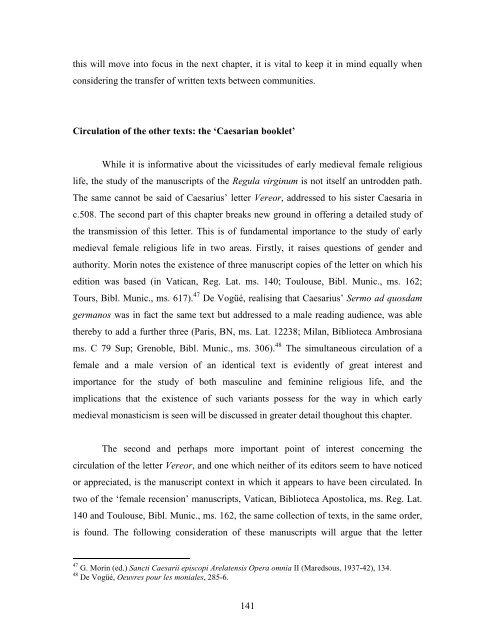Lindsay Rudge PhD Thesis - University of St Andrews
Lindsay Rudge PhD Thesis - University of St Andrews
Lindsay Rudge PhD Thesis - University of St Andrews
Create successful ePaper yourself
Turn your PDF publications into a flip-book with our unique Google optimized e-Paper software.
this will move into focus in the next chapter, it is vital to keep it in mind equally when<br />
considering the transfer <strong>of</strong> written texts between communities.<br />
Circulation <strong>of</strong> the other texts: the ‘Caesarian booklet’<br />
While it is informative about the vicissitudes <strong>of</strong> early medieval female religious<br />
life, the study <strong>of</strong> the manuscripts <strong>of</strong> the Regula virginum is not itself an untrodden path.<br />
The same cannot be said <strong>of</strong> Caesarius’ letter Vereor, addressed to his sister Caesaria in<br />
c.508. The second part <strong>of</strong> this chapter breaks new ground in <strong>of</strong>fering a detailed study <strong>of</strong><br />
the transmission <strong>of</strong> this letter. This is <strong>of</strong> fundamental importance to the study <strong>of</strong> early<br />
medieval female religious life in two areas. Firstly, it raises questions <strong>of</strong> gender and<br />
authority. Morin notes the existence <strong>of</strong> three manuscript copies <strong>of</strong> the letter on which his<br />
edition was based (in Vatican, Reg. Lat. ms. 140; Toulouse, Bibl. Munic., ms. 162;<br />
Tours, Bibl. Munic., ms. 617). 47 De Vogüé, realising that Caesarius’ Sermo ad quosdam<br />
germanos was in fact the same text but addressed to a male reading audience, was able<br />
thereby to add a further three (Paris, BN, ms. Lat. 12238; Milan, Biblioteca Ambrosiana<br />
ms. C 79 Sup; Grenoble, Bibl. Munic., ms. 306). 48 The simultaneous circulation <strong>of</strong> a<br />
female and a male version <strong>of</strong> an identical text is evidently <strong>of</strong> great interest and<br />
importance for the study <strong>of</strong> both masculine and feminine religious life, and the<br />
implications that the existence <strong>of</strong> such variants possess for the way in which early<br />
medieval monasticism is seen will be discussed in greater detail thoughout this chapter.<br />
The second and perhaps more important point <strong>of</strong> interest concerning the<br />
circulation <strong>of</strong> the letter Vereor, and one which neither <strong>of</strong> its editors seem to have noticed<br />
or appreciated, is the manuscript context in which it appears to have been circulated. In<br />
two <strong>of</strong> the ‘female recension’ manuscripts, Vatican, Biblioteca Apostolica, ms. Reg. Lat.<br />
140 and Toulouse, Bibl. Munic., ms. 162, the same collection <strong>of</strong> texts, in the same order,<br />
is found. The following consideration <strong>of</strong> these manuscripts will argue that the letter<br />
47 G. Morin (ed.) Sancti Caesarii episcopi Arelatensis Opera omnia II (Maredsous, 1937-42), 134.<br />
48 De Vogüé, Oeuvres pour les moniales, 285-6.<br />
141

















